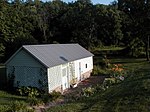Tomahawk Spring
Agricultural buildings and structures on the National Register of Historic Places in West VirginiaBerkeley County, West Virginia Registered Historic Place stubsBuildings and structures in Berkeley County, West VirginiaHouses completed in 1860National Register of Historic Places in Berkeley County, West Virginia ... and 1 more
Spring houses

Tomahawk Spring is a historic spring house located near Martinsburg, at Tomahawk, Berkeley County, West Virginia. It was built about 1860 on the stone foundation of a previous building. It is a one-story, wood-frame structure atop a three-feet-tall stone foundation in two sections. The first section is atop the spring and is approximately 16 by 12 feet (4.9 by 3.7 m), surrounded by a lattice enclosure. The second section contains a pool and is 13 by 12 feet (4.0 by 3.7 m).It was listed on the National Register of Historic Places in 1994.
Excerpt from the Wikipedia article Tomahawk Spring (License: CC BY-SA 3.0, Authors, Images).Tomahawk Spring
Tomahawk Run Road,
Geographical coordinates (GPS) Address Nearby Places Show on map
Geographical coordinates (GPS)
| Latitude | Longitude |
|---|---|
| N 39.531111111111 ° | E -78.0575 ° |
Address
Tomahawk Run Road 1856
25427
West Virginia, United States
Open on Google Maps




